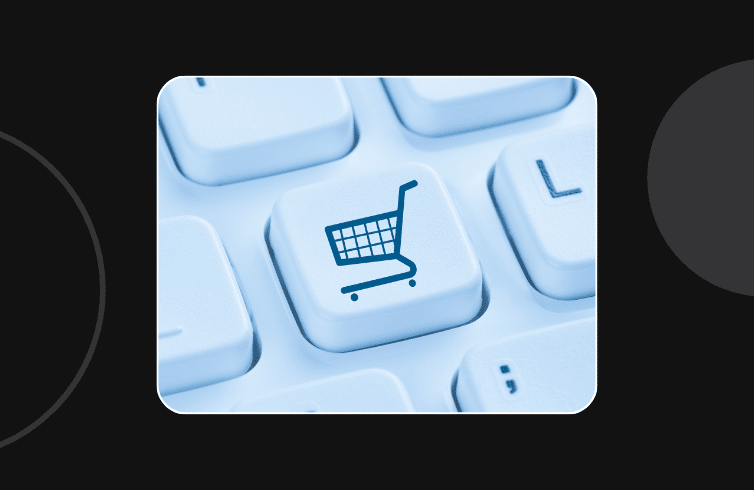Gain Control of Your Shopify Inventory with Predictive Management

Shopify’s built-in inventory tools are great for small stores, but they fall short as businesses scale and complexity increases.
Predictive inventory management adds intelligence and foresight, helping merchants anticipate demand, reduce stockouts, and optimize restocking decisions.
An AI-powered OMS like fabric seamlessly integrates with Shopify to unify inventory data, enable real-time syncing, and drive smarter fulfillment decisions across all channels.
With predictive insights and scalable infrastructure, Shopify merchants gain the confidence to expand SKUs, launch new channels, and future-proof their fulfillment strategy with fabric’s scalable OMS.
Shopify makes selling easy, but inventory control becomes increasingly complex as your operation scales. Scaling beyond your first handful of products exposes you to overselling, stockouts, manual inventory checks, and delayed fulfillments.
U.S. retailers lose around $82 billion annually due to stockouts, with online stores reporting an average out-of-stock rate of 7.4%. That’s money and trust, out the door.
However, with the right strategies and a comprehensive OMS with predictive tools, you can regain control and transform your inventory into a competitive advantage.
In this article, we’ll review how Shopify merchants can shift from reactive inventory management to proactive, predictive strategies that improve fulfillment performance and customer satisfaction.
Why inventory control gets challenging as you scale on Shopify
Shopify’s built-in inventory tools are great for simple setups, but complexity quickly creeps in when you:
- Add dozens or hundreds of stock-keeping units (SKUs) and product variants.
- Sell across multiple Shopify stores or external channels.
- Fulfill orders from a mix of distribution centers, physical stores, and dropship partners.
- Offer BOPIS, ship-from-store, or marketplace fulfillment services.
These complexities create hurdles such as,
- Inventory blind spots: Without centralized visibility, it’s hard to know what’s in stock and where, leading to missed sales or double-selling.
- Manual updates or miscounts: Relying on spreadsheets or manual entry increases the risk of human error and misaligned inventory levels.
- Delayed stock syncs across systems: Inventory data often updates in batches, creating a lag between what’s sold and what’s available.
- Reactive restocking and over-ordering: Without a centralized system, you may end up ordering too late or overcompensating because you’re reacting to sales data after the fact.
- Lost sales or costly stockouts: When inventory data is off, customers face out-of-stock notices or backorders, damaging trust and long-term loyalty.
These visibility issues aren’t unique to just a few merchants—34% of U.S. e-commerce brands report ongoing challenges managing inventory across multiple channels, which often leads to discrepancies, fulfillment delays, and frustrated customers.
What is predictive inventory management?
Predictive inventory management uses historical data, real-time sales trends, and intelligent forecasting to help you maintain the proper inventory levels at the right time.
Key capabilities:
- Forecasting demand based on seasonality, sales velocity, and market trends.
- Setting dynamic safety stock levels that adjust automatically as demand changes.
- Proactively flagging low stock before stockouts occur to enable timely restocking.
- Supporting smart purchasing, replenishment decisions, and inventory allocation.
This approach shifts the question from “what do we have now?” to “what will we need next?”, turning inventory from a reactive hurdle into a predictive advantage that drives operational efficiency and customer satisfaction.
Modern retailers are increasingly recognizing the value of this proactive approach. Over 50% of U.S. retailers plan to adopt AI-driven analytics by 2025 to forecast demand better and streamline their inventory operations. This shift underscores a growing reliance on predictive tools to reduce waste, prevent stockouts, and keep up with customer expectations across all sales channels.
How an OMS improves inventory control for Shopify merchants
An Order Management System (OMS) acts as the central nervous system for your inventory, gathering real-time data and applying smart logic so you can make proactive, data-driven decisions.
Key advantages of using an advanced OMS like fabric:
- Unified inventory visibility: A single source of truth across all your distribution centers, physical stores, dropshippers, and all your Shopify stores or channels.
- Automated stock updates: Real-time syncing ensures accuracy across all your channels, minimizing manual miscounts and preventing overselling.
- Forecasting and reorder recommendations: By combining sales history, velocity, and trends, fabric can suggest when to restock before your current stock runs out.
- Location-based insights: Learn where SKUs are most likely to sell and align inventory with demand, speeding up fulfillment and turnover.
- Exception handling: Automatic alerts for low stock, out-of-stocks, or mismatches enable fast resolution before issues impact your customers.
Actionable steps to gain more control over Shopify inventory
Here’s a hands-on roadmap for improving and unifying your inventory management system, whether you’re using fabric or not.
1. Audit your current inventory process
- Map where your inventory lives (DCs, stores, 3PLs) and how it flows into your Shopify environment.
- Document manual steps and data handoffs to identify weak links.
2. Centralize your inventory data
- Stop relying on siloed tools or manual spreadsheets.
- Sync all sources through an advanced OMS like fabric’s Order Management to keep your data unified.
3. Implement forecasting tools
- 73% of U.S. retailers report inaccurate forecasting as a persistent challenge, leading many to rely on manual processes or tools that don’t scale effectively. This highlights the clear need for more innovative, predictive forecasting methods.
- Use past sales, seasonality, and promotions to predict demand.
4. Set smart reorder points and safety stock
- Configure thresholds by product category or sales channel.
- Update them based on data to avoid overstocking.
5. Connect fulfillment and inventory decisions
- Ensure your routing strategy combines inventory levels with order fulfillment logic.
- This reduces split shipments and helps ensure faster deliveries.
6. Monitor and iterate
- Regularly check analytics to refine forecasts, reduce dead stock, and improve turnover.
- A dynamic dashboard with all necessary information can help you quickly spot issues and evaluate adjustments.
Benefits of predictive inventory control for Shopify stores
Tapping into predictive inventory control unlocks a cascade of tangible benefits for Shopify retailers:
1. Fewer stockouts = more sales captured
Predictive tools help you ensure that products stay in stock, reducing the risk of missed revenue opportunities.
2. Reduced overstock = less tied-up capital
More intelligent replenishment frees up cash by preventing excess inventory tied up in storage.
3. Improved fulfillment accuracy = fewer returns and support tickets
Accurate stock levels mean fewer errors, reduced customer complaints, and fewer returns processing.
4. Faster deliveries = happier customers
With stock positioned closer to demand and intelligent logistics, orders arrive quicker, boosting customer satisfaction and loyalty.
5. More confidence in expanding new channels
Predictive insights can empower your teams to add a new product or sales platforms without fearing stock issues.
Regain control and stay ahead of demand
Shopify can streamline the path to selling online, but once you start scaling and exceed simple inventory setups, you’ll need a more advanced system that can keep up with the complex dynamics of your evolving business.
By layering predictive insights and centralized visibility on top of your Shopify store, you can shift from constant firefighting to future-proofing. You’ll stay ahead of demand, minimize costly errors, and scale your Shopify store confidently.
Ready to elevate your Shopify inventory strategy? Request a demo today to discover how fabric’s AI-powered OMS enhances control, visibility, and fulfillment to keep your business ahead of the curve.

Digital content editorial team @ fabric




